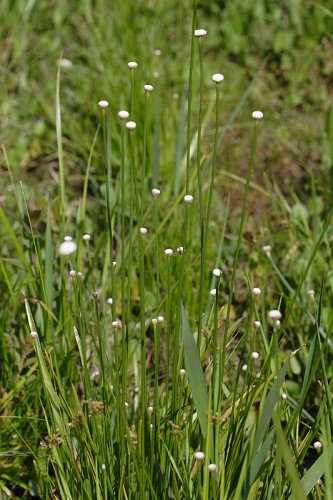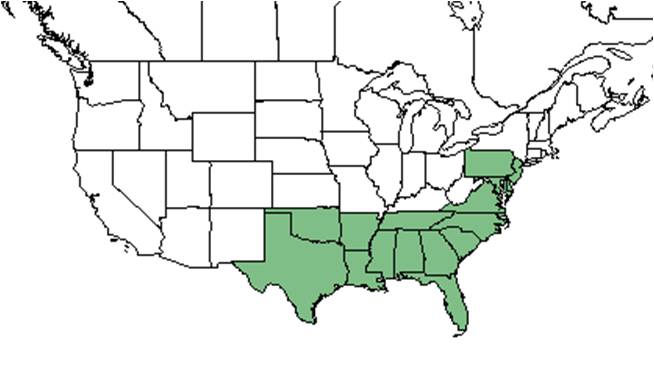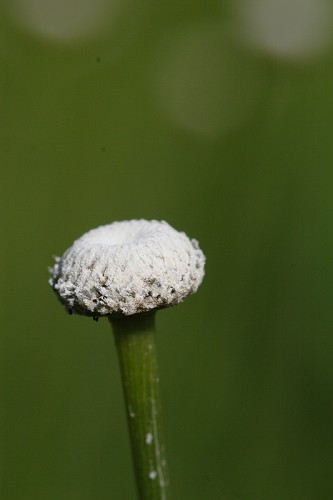Eriocaulon decangulare
| Eriocaulon decangulare | |
|---|---|

| |
| Photo by John R. Gwaltney, Southeastern Flora.com | |
| Scientific classification | |
| Kingdom: | Plantae |
| Division: | Magnoliophyta - Flowering plants |
| Class: | Liliopsida – Monocotyledons |
| Order: | Eriocaulales |
| Family: | Eriocaulaceae |
| Genus: | Eriocaulon |
| Species: | E. decangulare |
| Binomial name | |
| Eriocaulon decangulare L. | |

| |
| Natural range of Eriocaulon decangulare from USDA NRCS Plants Database. | |
Common name: Tenangle pipewort
Contents
Taxonomic notes
Varieties: Eriocaulon decangulare Linnaeus var. latifolium Chapman ex Moldenke; Eriocaulon decangulare Linnaeus var. decangulare
Description
A description of Eriocaulon decangulare is provided in The Flora of North America. Flowers of the Eriocaulon genus are arranged in a crowded head on a long and leafless stalk.[1]
Distribution
This species is distributed along the southeastern coastal plain from Pennsylvania and New Jersey south to Florida and west to Oklahoma and Texas.[2] E. decangulare var. decangulare can be found from New Jersey south to southern Florida, west to southwest Arkansas and eastern Texas, and south into Mexico and South America. E. decangulare var. latifolium can be found only in the panhandle of Florida, southern Alabama, and southern Mississippi.[3]
Ecology
Habitat
Habitats of E. decangulare var. decangulare include wet pine flatwoods and savannas, mafic fens and seeps, bogs, wind-tidal marshes, and seasonally flooded pools. As well, E. decangulare var. latifolium can be found in seepage bogs.[3] E. decangulare has been observed in a range of habitats including pond edges, in standing water of shallow ponds, moist depressions, bog muck, peaty margins, old stump hole depressions in savannas, sphagnous bogs, swampy areas, inundated pineland glades, and interdunal flats. Soils include sandy and wet soils, muck, moist to wet sandy peat, and rich loamy sand.[4] The species is listed by the USDA Natural Resources Conservation Service as an obligate wetland species that is almost exclusively found in wetland habitats.[2] It requires full sun, and has a low tolerance for calcium carbonate.[1]
Associated species include Pinus palustris, Pinus elliottii, Habenaria ciliaris, Balduina uniflora, Lilium catesbaei, Eragrostis elliottii, Rhynchospora sp., Cyrilla racemiflora, Taxodium sp., Aristida tussocks, Ilex coriacea, Lobelia brevifolia, Lobelia nuttallii, Polygala brevifolia, Polygala ramosa, Polygala lutea, Pluchea baccharis, Sarracenia flava, Rhexia petiolata, Lycopodium carolinianum, and Utricularia juncea.[4]
Phenology
Generally, E. decangulare flowers from June until October.[3] It has been observed flowering in January and also from March to November with peak inflorescence in June.[5][4]
Pollination
The following Hymenoptera families and species were observed visiting flowers of Eriocaulon decangulare at Archbold Biological Station: [6]
Colletidae: Hylaeus confluens
Halictidae: Halictus poeyi, Lasioglossum coreopsis, L. nymphalis, L. tamiamensis
Megachilidae: Megachile albitarsis
Sphecidae: Cerceris blakei, Ectemnius rufipes ais, Philanthus ventilabris
Vespidae: Pachodynerus erynnis, Stenodynerus fundatiformis, S. histrionalis rufustus
Conservation and management
This species is listed as extirpated by the Pennsylvania Department of Conservation and Natural Resources, and it is listed as endangered by the Tennessee Department of Environment and Conservation, Natural Heritage Program.[2]
Cultivation and restoration
Photo Gallery
Eriocaulon decangulare Photo by John R. Gwaltney, Southeastern Flora.com
References and notes
- ↑ 1.0 1.1 [[1]] Lady Bird Johnson Wildflower Center. Accessed: May 9, 2019
- ↑ 2.0 2.1 2.2 USDA, NRCS. (2016). The PLANTS Database (http://plants.usda.gov, 9 May 2019). National Plant Data Team, Greensboro, NC 27401-4901 USA.
- ↑ 3.0 3.1 3.2 Weakley, A. S. (2015). Flora of the Southern and Mid-Atlantic States. Chapel Hill, NC, University of North Carolina Herbarium.
- ↑ 4.0 4.1 4.2 Florida State University Robert K. Godfrey Herbarium database. URL: http://herbarium.bio.fsu.edu. Last accessed: May 2019. Collectors: Frank Almeda, Loran C. Anderson, Wilson Baker, Wade Biltoft, Keith Bradley, Edwin L. Bridges, Rev. Robert Brinker, Jenny Britten, Daniel Castillo, Andre F. Clewell, R. J. Coile, George R. Cooley, A. H. Curtiss, Richard J. Eaton, Nancy Edmonson, D. L. Fichtner, Paul Fortsch, Robert K. Godfrey, Bruce Hansen, JoAnn Hansen, Gary R. Knight, R. Komarek, Mabel Kral, Robert Kral, Olga Lakela, Robert L. Lazor, Robert J Lemaire, S. W. Leonard, Sidney McDaniel, Thomas E. Miller, Marc Minno, Melanie Mitchell, Richard S. Mitchell, John B. Nelson, R. A. Norris, Steve L. Orzell, R. E. Perdue, Jr., Richard Porcher, Gwynn W. Ramsey, P. L. Redfearn, P. L. Redfearn, Jr., Grady W. Reinert, Amanda Sang, Cecil R. Slaughter, William R. Stimson, and Jean W. Wooten. States and Counties: Florida: Bay, Brevard, Broward, Calhoun, Clay, Collier, Dixie, Duval, Escambia, Franklin, Gadsden, Gulf, Hillsborough, Indian River, Jackson, Jefferson, Levy, Liberty, Madison, Manatee, Martin, Okaloosa, Orange, Osceola, Palm Beach, Santa Rosa, Sarasota, St Johns, St Lucie, Sumter, Wakulla, Walton, and Washington. Georgia: Clinch, Thomas, and Worth. South Carolina: Berkeley.
- ↑ Nelson, G. PanFlora: Plant data for the eastern United States with emphasis on the Southeastern Coastal Plains, Florida, and the Florida Panhandle. www.gilnelson.com/PanFlora/ Accessed: 9 DEC 2016
- ↑ Deyrup, M.A. and N.D. 2015. Database of observations of Hymenoptera visitations to flowers of plants on Archbold Biological Station, Florida, USA.
